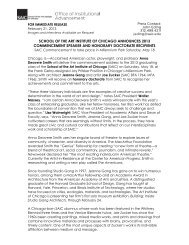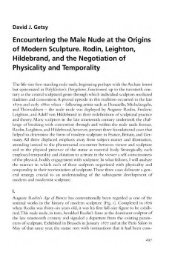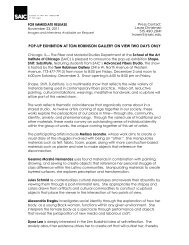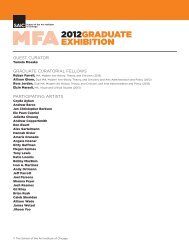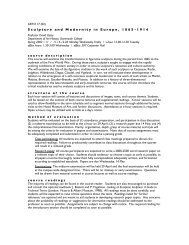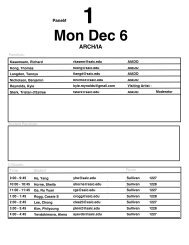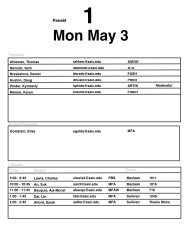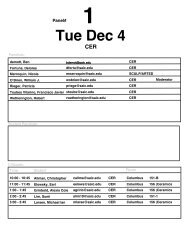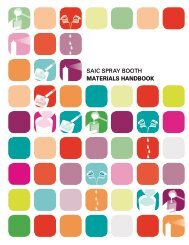i. institutional support and commitment to continuous improvement
i. institutional support and commitment to continuous improvement
i. institutional support and commitment to continuous improvement
Create successful ePaper yourself
Turn your PDF publications into a flip-book with our unique Google optimized e-Paper software.
School of the Art Institute of Chicago<br />
Department of Architecture, Interior Architecture, <strong>and</strong> Designed Objects<br />
Master of Architecture<br />
Master of Architecture with emphasis in Interior Architecture<br />
B) Institutional planning<br />
During the 2008–09 academic year, the suggestion for adding a new, high-level administrative officer<br />
who could synthesize the needs of the institution <strong>and</strong> its resources was suggested by the Office of<br />
the President. Over the next three semesters, this idea was vetted by <strong>and</strong> among decision-makers<br />
including the Board of Governors, the Office of the President, the Office of the Deans <strong>and</strong> Division<br />
Chairs, the Office of Student Affairs, Fiscal Affairs, Human Resources, <strong>and</strong> the Faculty Senate. Slowly, a<br />
plan emerged <strong>to</strong> pursue such a new position by first creating a temporary position, the Interim Senior<br />
Vice President of Academic Administration, <strong>and</strong> staffing it with an external, retired former college<br />
president who would have a depth of experience, a generosity of knowledge, <strong>and</strong> an unattached,<br />
short-term investment with which <strong>to</strong> help SAIC shape this new chief administrative position in a frank<br />
fashion. After a search process, Robert Miller was retained in this position, <strong>and</strong> through his one-year<br />
appointment during the 2009-10 academic year, Miller marshaled the efforts of administration <strong>and</strong><br />
faculty governance <strong>to</strong>wards two major initiatives: a) create <strong>and</strong> fill the position of Provost <strong>and</strong> Senior<br />
Vice President of Academic Affairs; <strong>and</strong> b) initiate a major Strategic Planning initiative, resulting in a<br />
five-year plan.<br />
1) Provost<br />
By the time Miller was appointed, administration <strong>and</strong> faculty governance at SAIC had come <strong>to</strong> an<br />
agreement that a Provost would be needed for the School, which had grown exponentially in size<br />
<strong>and</strong> scope in the past two decades. Through a series of conversations facilitated by Miller, agreement<br />
was reached for a Provost position, reporting directly <strong>to</strong> the President of the School. An international<br />
search was conducted by a search committee, which, notably, was comprised of an unprecedented<br />
diversity of faculty; staff from academic, student, <strong>and</strong> management areas; <strong>and</strong> Governors. The<br />
committee selected a search firm <strong>to</strong> augment SAIC’s regular recruitment methods, <strong>and</strong>, ultimately,<br />
Dr. Elissa Tenny—formerly Provost <strong>and</strong> Dean at Benning<strong>to</strong>n College <strong>and</strong>, prior <strong>to</strong> that, Vice Dean at<br />
the New School for Social Research—was hired as SAIC’s Provost beginning in Fall 2010.<br />
2) Strategic planning<br />
Provost Tenny will assume management of the Strategic Planning Committee, comprised of 13 members:<br />
five full-time faculty members, including current MArch Program Head Douglas Pancoast; one part-time<br />
faculty member; the Dean of Faculty <strong>and</strong> the Undergraduate Division Chair, who are both tenured faculty<br />
currently serving in administrative roles; the Dean of Student Affairs; one representative from Student<br />
Association, SAIC’s student leadership body; the Chief Operating Officer; one representative from the<br />
Board of Governors; <strong>and</strong> one staff secretary. Beginning with a professionally facilitated retreat at the<br />
beginning of Spring 2010, the committee drafted a list of Core Values <strong>and</strong> Strategic Initiatives that were<br />
then shared with a wide breadth of stakeholders in the institution, including: the President’s Cabinet,<br />
Academic Cabinet, the Office of Student Affairs, an ad hoc committee of <strong>institutional</strong> executives,<br />
academic Department Heads, academic Administrative Direc<strong>to</strong>rs, Student Association, <strong>and</strong> the Faculty<br />
Senate. There was also an All-School meeting open <strong>to</strong> all members of the School community, a website<br />
where individual students, faculty, <strong>and</strong> staff’s comments <strong>and</strong> criticisms were compiled <strong>and</strong>, finally, a<br />
drop-box where responses were anonymously collected.<br />
After each exchange, the Strategic Planning Committee vetted <strong>and</strong> re-drafted the values <strong>and</strong><br />
initiatives, internalizing the feedback they had received. From the beginning responses <strong>to</strong> the<br />
committee’s work were positive, citing that they had described some essential characteristics <strong>and</strong><br />
clarified keen challenges for SAIC. In May 2010, the committee presented the values <strong>and</strong> initiatives <strong>to</strong><br />
the Board of Governors, who applauded them as the most succinct description of the School they<br />
had ever been presented. The Core Values <strong>and</strong> Strategic Initiatives are summarized below.<br />
Architecture Program Report | 30



